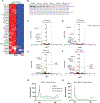Mutant NPM1 Directly Regulates Oncogenic Transcription in Acute Myeloid Leukemia
- PMID: 36455613
- PMCID: PMC10084473
- DOI: 10.1158/2159-8290.CD-22-0366
Mutant NPM1 Directly Regulates Oncogenic Transcription in Acute Myeloid Leukemia
Abstract
The dysregulation of developmental and stem cell-associated genes is a common phenomenon during cancer development. Around half of patients with acute myeloid leukemia (AML) express high levels of HOXA cluster genes and MEIS1. Most of these AML cases harbor an NPM1 mutation (NPM1c), which encodes for an oncoprotein mislocalized from the nucleolus to the cytoplasm. How NPM1c expression in hematopoietic cells leads to its characteristic gene-expression pattern remains unclear. Here, we show that NPM1c directly binds to specific chromatin targets, which are co-occupied by the histone methyltransferase KMT2A (MLL1). Targeted degradation of NPM1c leads to a rapid decrease in gene expression and loss of RNA polymerase II, as well as activating histone modifications at its targets. We demonstrate that NPM1c directly regulates oncogenic gene expression in collaboration with the MLL1 complex and define the mechanism by which MLL1-Menin small-molecule inhibitors produce clinical responses in patients with NPM1-mutated AML.
Significance: We uncovered an important functional role of mutant NPM1 as a crucial direct driver of oncogenic gene expression in AML. NPM1c can bind to chromatin and cooperate with the MLL complex, providing the first functional insight into the mechanism of Menin-MLL inhibition in NPM1c leukemias. See related article by Wang et al., p. 724. This article is highlighted in the In This Issue feature, p. 517.
©2022 American Association for Cancer Research.
Figures






Comment in
-
Mutant NPM1 Hijacks Transcriptional Hubs to Maintain Pathogenic Gene Programs in Acute Myeloid Leukemia.Cancer Discov. 2023 Mar 1;13(3):724-745. doi: 10.1158/2159-8290.CD-22-0424. Cancer Discov. 2023. PMID: 36455589 Free PMC article.
Comment on
-
Mutant NPM1 Hijacks Transcriptional Hubs to Maintain Pathogenic Gene Programs in Acute Myeloid Leukemia.Cancer Discov. 2023 Mar 1;13(3):724-745. doi: 10.1158/2159-8290.CD-22-0424. Cancer Discov. 2023. PMID: 36455589 Free PMC article.
References
-
- Döhner H, Weisdorf DJ, Bloomfield CD. Acute Myeloid Leukemia. N Engl J Med. 2015;373:1136–52. - PubMed
-
- Falini B, Brunetti L, Sportoletti P, Paola Martelli M. NPM1-mutated acute myeloid leukemia: from bench to bedside. Blood. 2020;136:1707–21. - PubMed
-
- Falini B, Mecucci C, Tiacci E, Alcalay M, Rosati R, Pasqualucci L, et al. Cytoplasmic nucleophosmin in acute myelogenous leukemia with a normal karyotype. N Engl J Med. 2005;352:254–66. - PubMed
Publication types
MeSH terms
Substances
Grants and funding
LinkOut - more resources
Full Text Sources
Medical
Molecular Biology Databases
Research Materials

